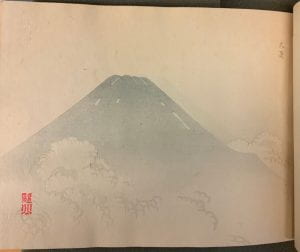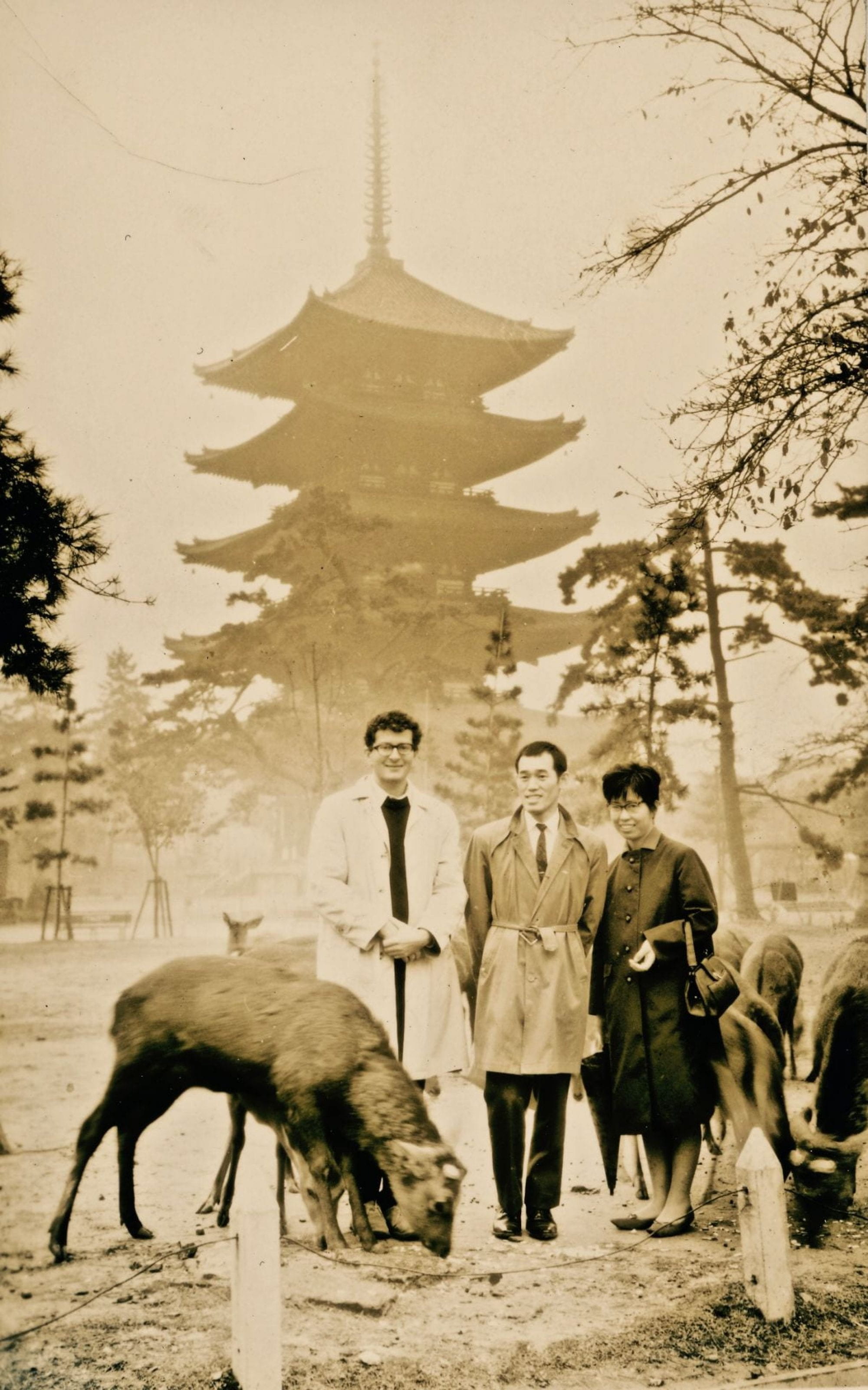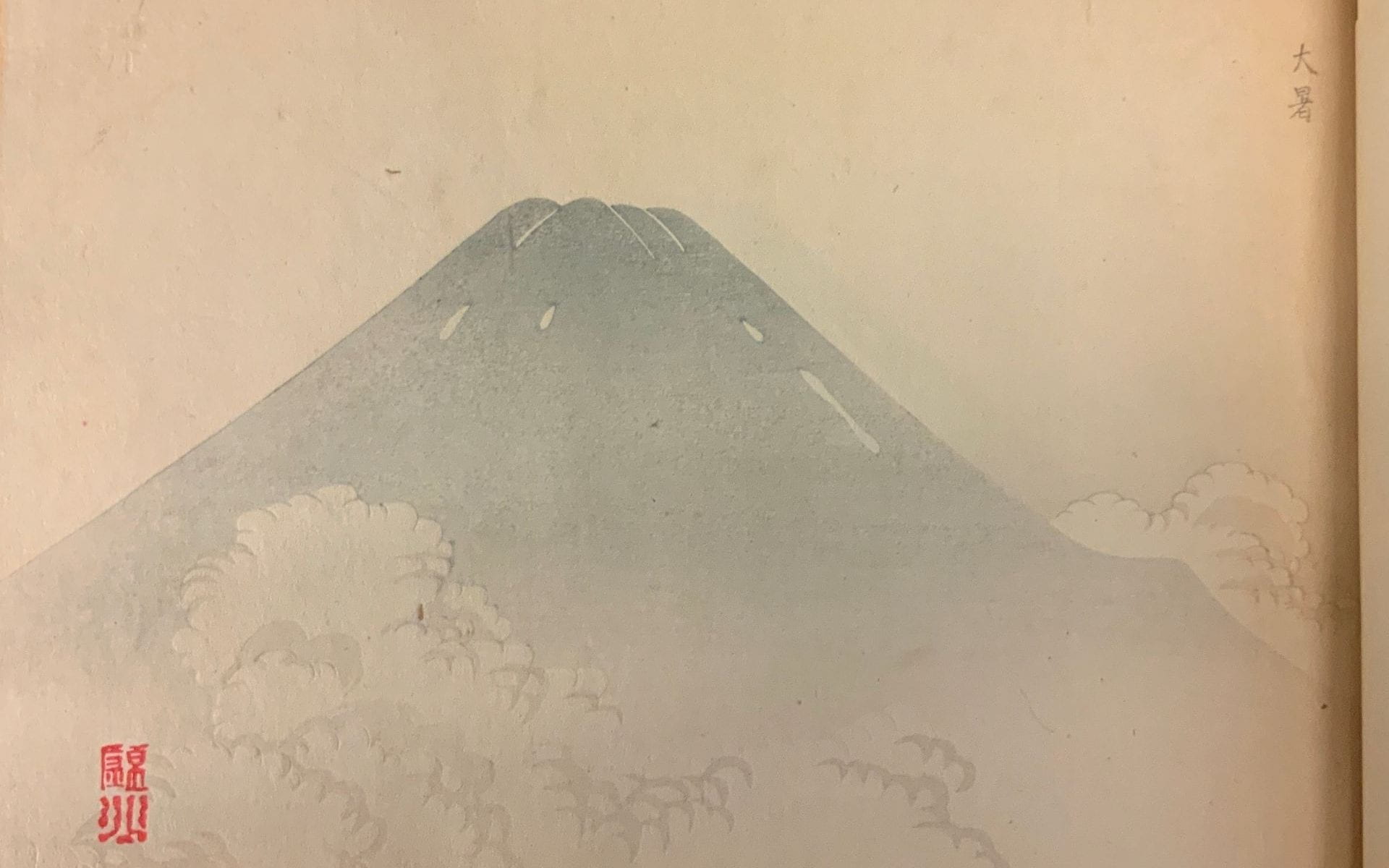
Artist: Haruna Shigeharu 春名繁春 (1847-1913)
Title: Fugaku shinkei 富嶽真景
Date of Publication: 1894, Publisher: Gunshojō, Shimomura Shotaro
Medium: Woodblock printed, ink and color on paper.
Dimensions: 18.5 x 25.1 x 0.8 cm (Pulverer)
Gift of: Tress, Arthur (donor) (Tress Collection copy)
Kislak Center for Special Collections – Arthur Tress Collection. Box 45, Item 21.
The Fugaku shinkei 富嶽真景 (True Pictures of Mt. Fuji) is created by the artist Haruna Shigeharu 春名繁春. Haruna Shigeharu was known as a painter of Kutani porcelain. The book is made with a fukurotoji binding but in a horizontal (yokobon) format with four hold binding. After the first four pages, additional folios have been supported a sheet of a thin paper inside the folded page, likely a later conservation intervention. In addition to the bizarre construction, page 5 does not have an image on the back, and this is consistent throughout the book for the remainder of the 32 images. The leaves after page 5 then transition to a butterfly binding.
The colophon reports the book is a single volume, complete (zen).
Artwork Analysis:
The thirty-two images show Mt. Fuji from a single perspective, and while Mt. Fuji is the subject for this book, the book does much more. The character of the mountain is not just defined by its iconic shape. Yet while the shape is important, so that the viewer understands where they are in Japan when observing the mountain, the book is a conversation between the mountain, the seasons and weather, and the observer. The view of Mt. Fuji as represented in the book is presented from the south, as though the observer is standing south of the mountain looking towards the north. Today, this view can be seen from the Shinkansen (bullet train) after the train departs from Mishima Station and towards . This view can be identified by the way that Mt. Fuji’s iconic second bump which can be observed from this angle.
The book was advertised in 1895 in The Japan Weekly Mail where it was described:
“Fugaku shinkyo, or Views of Fuji, is the title of a little album containing no less than 32 sketches of the summit of the peerless mountain, in all weathers and at all seasons. The exquisite symmetry and graceful shape of Fujiyama evoke a kind of reverential love in Japanese bosoins. Never, we believe, has any natural object received such tender worship or played such a large part in the art of a nation. Mr. Haruna Shigeharu, the painter of these 32 pictures, must have made the mountain a perpetual study. It is worthy of such attention, and the public will be grateful for this result of his labour of love.”
I realized that Fugaku shinkei appears to be simple in its physical presentation, but the more a reader spends time with the book the more details are exposed to the reader. It is much like when one sits with the view of the mountain in their visual field, no matter for a moment or an hour, the viewer will have a different experience along with a different perception of the space. For example, if a reader looks closely, there are detailed impressions of characters in the top left of the pages. But the book reveals more when it is observed with raking light. Details appear that contour the shapes in the landscape, this gives a deeper definition and texture to the space. The pages are more three dimensional than they initially appear. Though I can only speculate now about the artist’s intention, I believe the artist (and his collaborators, the carvers and printers) intended for this subtle detail to be discovered over time, much like how the subject, Mt. Fuji, changes over time in different weather and seasons, often in ways not noticeable or abrupt. This suggests to me that the book is observational by nature.
Haruna Shigeharu must have spent a considerable amount of time observing Mt. Fuji from the southern perspective to show such a variety of images of the same place. While the view is the same, it is always in flux, and while the mountain indexes as an icon in our consciousness, in reality, nature is what indexes our perception of the mountain in the moment. Thus, this is why a book with the “same” thirty-two images of Mt. Fuji can be so complex and polarizing.
Other Copies of the Book:
- Library of Congress: https://lccn.loc.gov/2002585962
- Pulverer Collection, Freer Gallery of Art, Smithsonian Washington DC http://pulverer.si.edu/node/1143/title/1
Selected Readings:
- Japan Weekly Mail: A Review of Japanese Commerce, Politics, Literature, and Art. Vol XIII, 1895. https://books.google.com/books?id=FXM9AQAAMAAJ&pg=PA89&dq=haruna+shigeharu&hl=en&newbks=1&newbks_redir=0&sa=X&ved=2ahUKEwihmKCM9N3nAhXumXIEHbqJB9UQ6AEwBXoECAYQAg#v=onepage&q=haruna%20shigeharu&f=false
Posted by Derek Rodenbeck
April 15th, 2020

